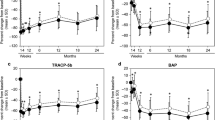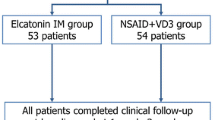Abstract
The acute-phase response (APR) is a frequent occurrence after infusion of zoledronic acid and is caused by activation of γδ T cells. Vitamin D receptor is expressed in immune cells, and vitamin D has immunomodulatory properties. The aim of this prospective study was to test the effect of vitamin D (cholecalciferol) on the incidence of APR and intensity of pain in women undergoing infusion of zoledronic acid for postmenopausal osteoporosis. 60 women were enrolled and randomized into two groups. At baseline, 30 women received an oral bolus of cholecalciferol (300,000 IU), while another 30 women received placebo. On day 5 both groups were treated with a single infusion of zoledronic acid (5 mg) and received a daily supplementation of calcium (1,000 mg) and vitamin D (800 IU). Patients were clinically evaluated and inflammatory markers were assayed before zoledronic acid administration and every 24 h for the following 2 days. The onset of APR has been defined by the occurrence of fever or at least one of the typical symptoms, such as musculoskeletal pain after zoledronic acid infusion. Intensity of pain was measured by a one-dimensional scale (0 = no pain, 10 = unbearable pain). APR developed in 66.6% of patients, with no significant difference between groups. The vitamin group experienced less musculoskeletal pain [median 1 (0–4) vs. 2 (1–8), P < 0.05] and exhibited lower inflammatory markers (P < 0.005 vs. placebo). Our data demonstrate that cholecalciferol at a dose of 300,000 IU reduces the intensity of musculoskeletal pain after infusion of zoledronic acid for postmenopausal osteoporosis.
Similar content being viewed by others
References
Rachner TD, Khosla S, Hofbauer LC (2011) Osteoporosis: now and the future. Lancet 377(9773):1276–1287
Eastell R, Walsh JS, Watts NB, Siris E (2011) Bisphosphonates for postmenopausal osteoporosis. Bone 49(1):82–88
Black DM, Delmas PD, Eastell R, Reid IR, Boonen S, Cauley JA, Cosman F, Lakatos P, Leung PC, Man Z, Mautalen C, Mesenbrink P, Hu H, Caminis J, Tong K, Rosario-Jansen T, Krasnow J, Hue TF, Sellmeyer D, Eriksen EF, Cummings SR, HORIZON Pivotal Fracture Trial (2007) Once-yearly zoledronic acid for treatment of postmenopausal osteoporosis. N Engl J Med 356:1809–1822
Adami S, Bhalla AK, Dorizzi R, Montesanti F, Rosini S, Salvagno G, Lo Cascio V (1987) The acute phase response after bisphosphonates administration. Calcif Tissue Int 41:326–331
Strampel W, Emkey R, Civitelli R (2007) Safety considerations with bisphosphonates for the treatment of osteoporosis. Drug Saf 30:755–763
Rizzoli R, Reginster JY, Boonen S, Breart G, Diez-Perez A, Felsenberg D, Kaufman JM, Kanis JA, Cooper C (2011) Adverse reaction and drug–drug interactions in the management of women with postmenopausal osteoporosis. Calcif Tissue Int 89:91–104
Ceciliani F, Giordano A, Spagnolo V (2002) The systemic reaction during inflammation: the acute-phase proteins. Protein Pept Lett 9:211–223
Thiebaud D, Sauty A, Burckhardt P, Leuenberger P, Sitzler L, Green JR, Kandra A, Zieschang J, Ibarra de Palacios P (1997) An in vitro and in vivo study of cytokines in the acute-phase response associated with bisphosphonates. Calcif Tissue Int 61:386–392
Galluzzo S, Santini D, Vincenzi B, Caccamo N, Meraviglia F, Salerno A, Dieli F, Tonini G (2007) Immunomodulating role of bisphosphonates on human γ, δ T cells: an intriguing and promising aspect of their antitumour activity. Expert Opin Ther Targets 11:941–954
Roelofs AJ, Thompson K, Gordon S, Rogers MJ (2006) Molecular mechanisms of action of bisphosphonates: current status. Clin Cancer Res 12:6222–6230
Hewitt RE, Lissina A, Green AE, Slay ES, Price DA, Sewell AK (2005) The bisphosphonate acute phase response: rapid and copious production of proinflammatory cytokines by peripheral blood γ, δ T cells in response to aminobisphosphonates is inhibited by statins. Clin Exp Immunol 139:101–111
Reid IR, Gamble GD, Mesenbrink P, Lakatos P, Black DM (2010) Characterization of and risk factors for the acute-phase response after zoledronic acid. J Clin Endocrinol Metab 95:4380–4387
Bertoldo F, Pancheri S, Zenari S, Boldini S, Giovanazzi B, Zanatta M, Valenti MT, Dalle Carbonare L, Lo Cascio V (2010) Serum 25-hydroxyvitamin D levels modulate the acute-phase response associated with the first nitrogen-containing bisphosphonate infusion. J Bone Miner Res 25(3):447–454
Srivastava T, Dai H, Haney CJ, Alon US (2011) Serum 25-hydroxyvitamin D level and acute-phase reaction following initial intravenous bisphosphonate. J Bone Miner Res 26(2):437–438
Wang T-T, Nestel FP, Bourdeau V, Nagai Y, Wang Q, Liao J, Tavera-Mendoza L, Lin R, Hanrahan JH, Mader S, White JH (2004) Cutting edge: 1,25-dihydroxyvitamin D3 is a direct inducer of antimicrobial peptide gene expression. J Immunol 173:2909–2912
Mathieu C, Van Etten E, Gysemans C, Gysemans C, Decallonne B, Kato S, Laurevs J, Depovere J, Valckx D, Verstuyf A, Bouillon R (2001) In vitro and in vivo analysis of the immune system of vitamin D receptor knockout mice. J Bone Miner Res 16:2057–2065
Boonstra A, Barrat FJ, Crain C, Health VL, Savelkoul HF, O’Garra A (2001) 1α,25-Dihydroxyvitamin D3 has a direct effect on naive CD4+ T cells to enhance the development of Th2 cells. J Immunol 167:4974–4980
Gregori S, Giarratana N, Smiroldo S, Uskokovic M, Adorini L (2002) A 1α,25-dihydroxyvitamin D3 analog enhances regulatory T cells and arrests autoimmune diabetes in NOD mice. Diabetes 51:1367–1374
Qi X-P, Pei L, Gang L, Sun Z, Li J-S (2008) 1,25-Dihydroxyvitamin D3 regulates LPS-induced cytokine production and reduces mortality in rats. World J Gastroenterol 14(24):3897–3902
Chen L, Cencioni MT, Angelini DF, Borsellino G, Battistini L, Brosnan CF (2005) Transcriptional profiling of γ, δ T cells identifies a role for vitamin D in the immunoregulation of the Vg9Vd2 response to phosphonate containing ligands. J Immunol 174(10):6144–6152
Holick MF (2007) Vitamin D deficiency. N Engl J Med 357:266–281
Genant HK, Wu CY, van Kuijk C, Nevitt MC (1993) Vertebral fracture assessment using a semiquantitative technique. J Bone Miner Res 8(9):1137–1148
Thompson K, Rogers MJ (2004) Statins prevent bisphosphonate-induced γ, δ T-cell proliferation and activation in vitro. J Bone Miner Res 19(2):278–288
Edfeldt K, Liu PT, Chun R, Fabri M, Schenk M, Wheelwright M, Keegan C, Krutzik SR, Adams JS, Hewison M, Modlin RL (2010) T-cell cytokines differentially control human monocyte antimicrobial responses by regulating vitamin D metabolism. Proc Natl Acad Sci USA 107(52):22593–22598
Cipriani C, Romagnoli E, Scillitani A, Chiodini I, Clerico R, Carnevale V, Mascia ML, Battista C, Viti R, Pileri M, Eller-Vainicher C, Minisola S (2010) Effect of a single oral dose of 600,000 IU of cholecalciferol on serum calciotropic hormones in young subjects with vitamin D deficiency: a prospective intervention study. J Clin Endocrinol Metab 95(10):4771–4777
Romagnoli E, Mascia ML, Cipriani C, Fassino V, Mazzei F, D’Erasmo E, Carnevale V, Scillitani A, Minisola S (2008) Short and long term variations in serum calciotropic hormones after a single very large dose of ergocolecalciferol (vitamin D2) or cholecalciferol (vitamin D3) in the elderly. J Clin Endocrinol Metab 93:3015–3020
Araki T, Holick MF, Alfonso BD, Charlap E, Romero CM, Rizk D, Newman LG (2011) Vitamin D intoxication with severe hypercalcemia due to manufacturing and labeling errors of two dietary supplements made in the United States. J Clin Endocrinol Metab. doi:10.1210/jc.2011-1443
Penna G, Adorini L (2000) 1α,25-Dihydroxyvitamin D3 inhibits differentiation, maturation, activation, and survival of dendritic cells leading to impaired alloreactive T cell activation. J Immunol 164:2405–2411
Griffin MD, Lutz W, Phan VA, Bachman LA, McKean DJ, Kumar R (2001) Dendritic cell modulation by 1α,25 dihydroxyvitamin D3 and its analogs: a vitamin D receptor-dependent pathway that promotes a persistent state of immaturity in vitro and in vivo. Proc Natl Acad Sci USA 98:6800–6805
Overbergh L, Decallonne B, Waer M, Rutgeerts O, Valckx D, Casteels KM, Laureys J, Bouillon R, Mathieu C (2000) 1α,25-Dihydroxyvitamin D3 induces an autoantigen-specific T-helper 1/T-helper 2 immune shift in NOD mice immunized withGAD65 (p524–543). Diabetes 49:1301–1307
Woodhouse PR, Khaw KT, Plummer M, Foley A, Meade TW (1994) Seasonal variations of plasma fibrinogen and factor VII activity in the elderly: winter infections and death from cardiovascular disease. Lancet 343:435–439
Rothenbacher D, Hoffmeister A, Brenner H, Koenig W (2003) Physical activity, coronary heart disease, and inflammatory response. Arch Intern Med 163:1200–1205
Reuben DB, Judd-Hamilton L, Harris TB, Seeman TE (2003) The associations between physical activity and inflammatory markers in high functioning older persons: McArthur studies of successful aging. J Am Geriatr Soc 51:1125–1130
Koenig W, Sund M, Doring A, Ernst E (1997) Leisure time physical activity but not work related physical activity is associated with decreased plasma viscosity: results from a large population sample. Circulation 95:335–341
Yarnell JW, Sweetnam PM, Rumley A, Lowe GD (2000) Lifestyle and hemostatic risk factors for ischemic heart disease: the Caerphilly study. Arterioscler Thromb Vasc Biol 20:271–279
Moreno J, Krishnan AV, Swami S, Nonn L, Peehl DM, Feldman D (2005) Regulation of prostaglandin metabolism by calcitriol attenuates growth stimulation in prostate cancer cells. Cancer Res 65(17):7917–7925
Author information
Authors and Affiliations
Corresponding author
Additional information
The authors have stated that they have no conflict of interest.
Rights and permissions
About this article
Cite this article
Catalano, A., Morabito, N., Atteritano, M. et al. Vitamin D Reduces Musculoskeletal Pain After Infusion of Zoledronic Acid for Postmenopausal Osteoporosis. Calcif Tissue Int 90, 279–285 (2012). https://doi.org/10.1007/s00223-012-9577-6
Received:
Accepted:
Published:
Issue Date:
DOI: https://doi.org/10.1007/s00223-012-9577-6




